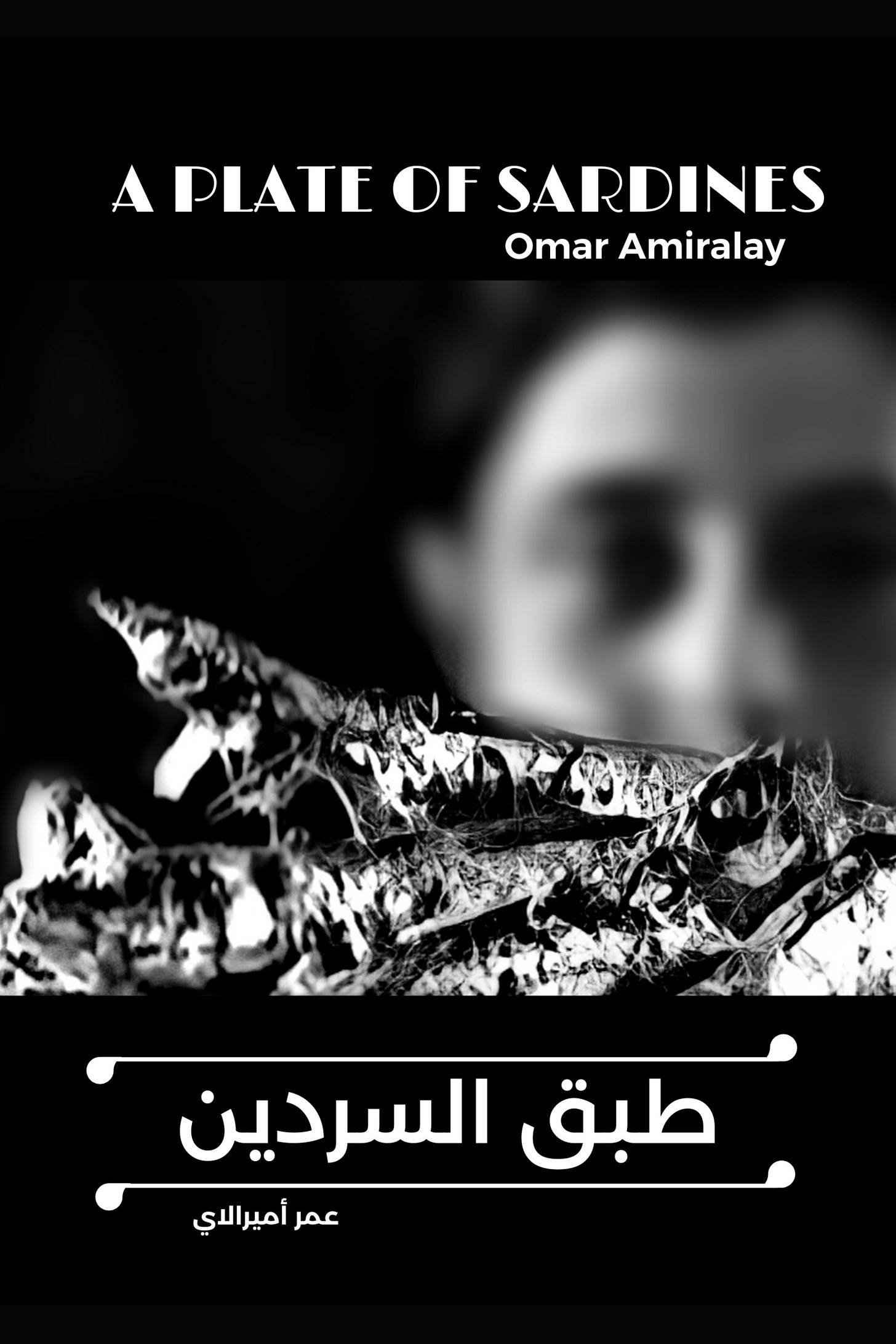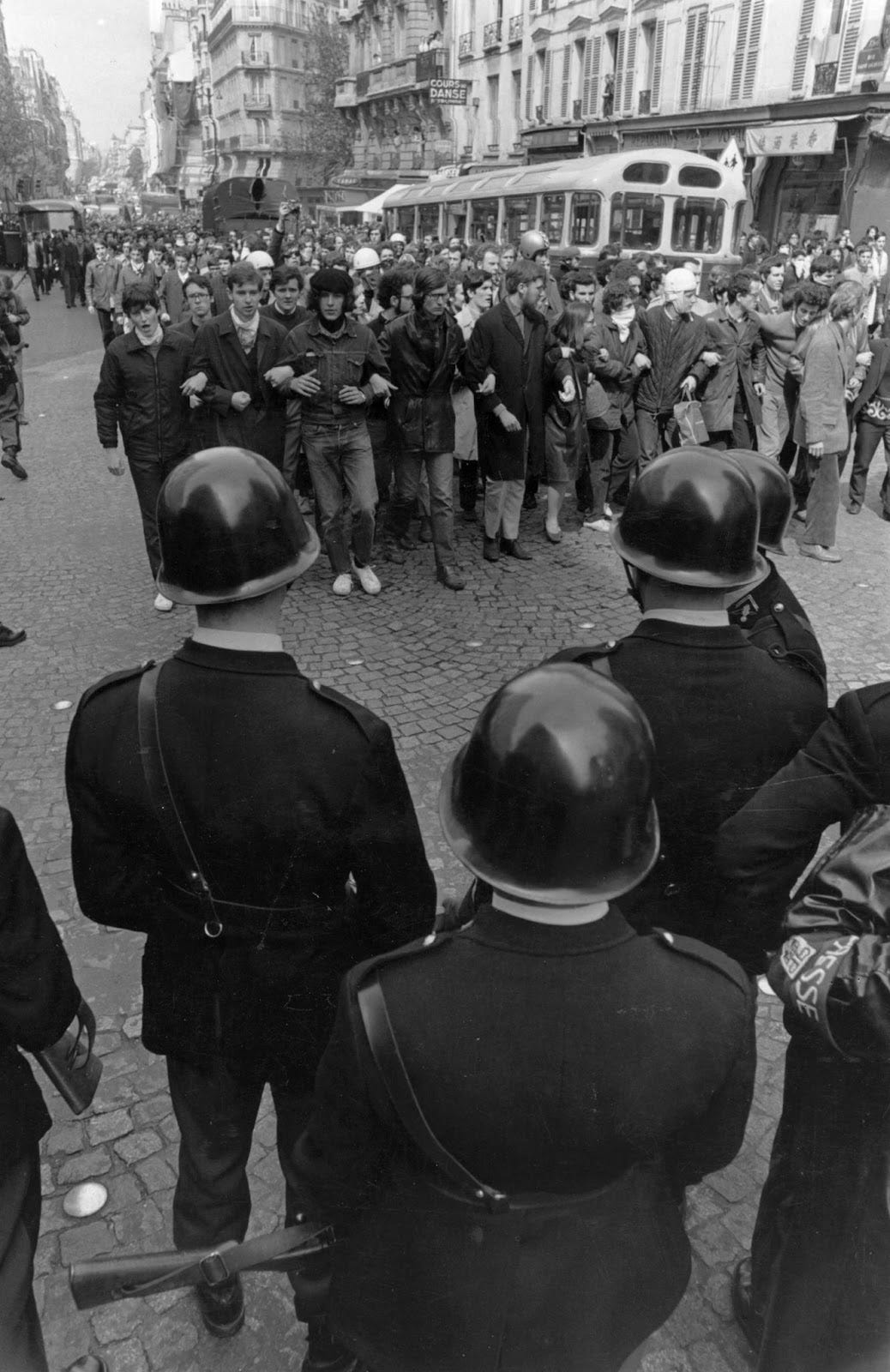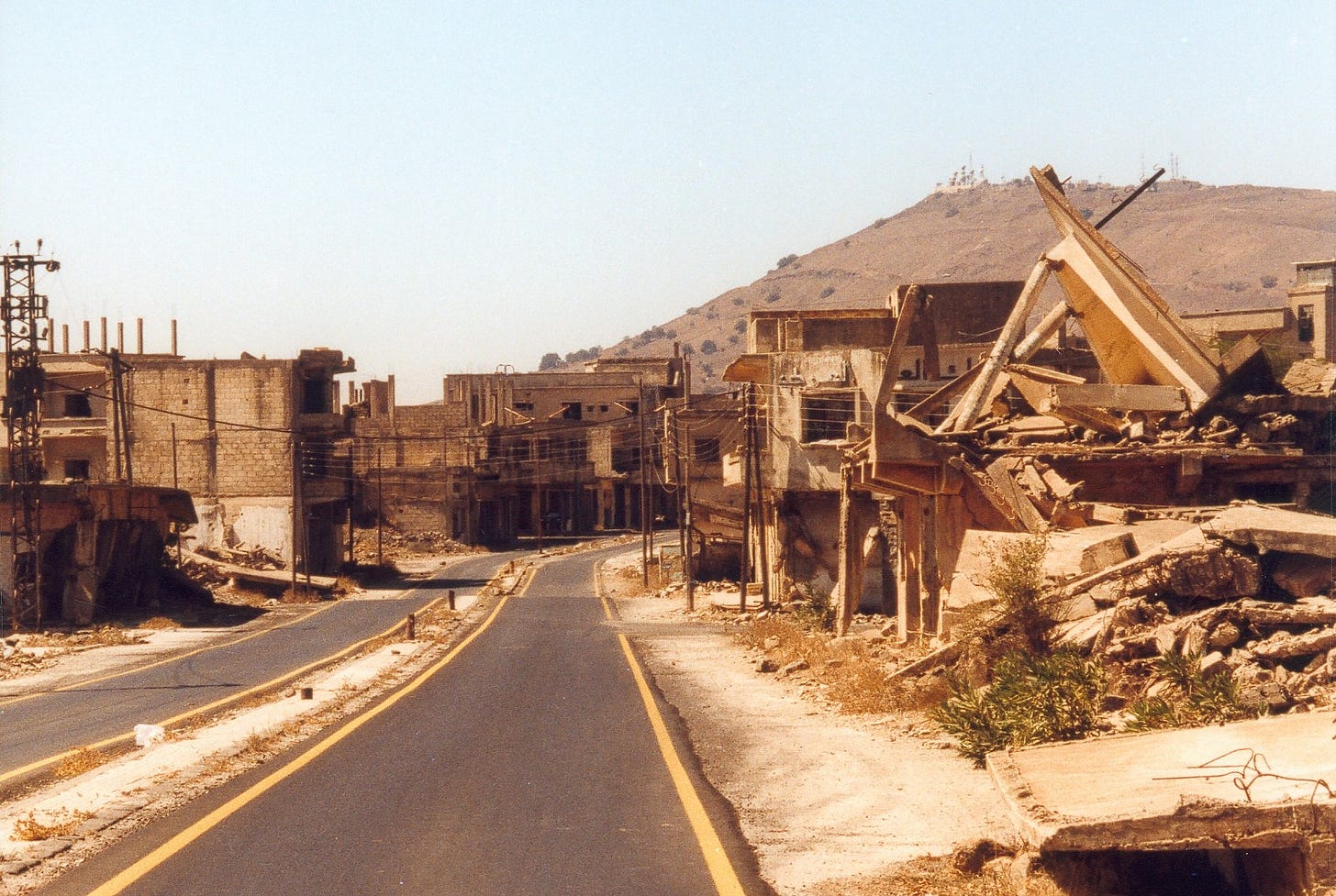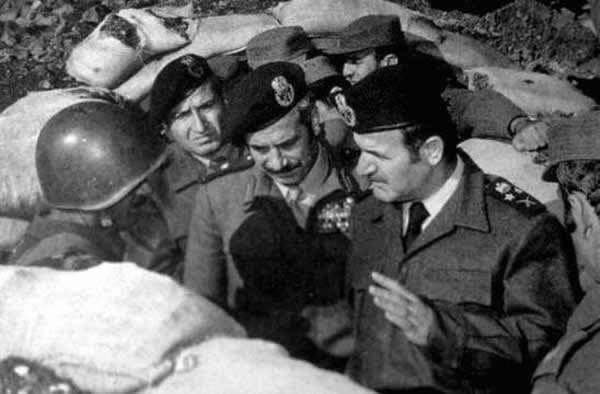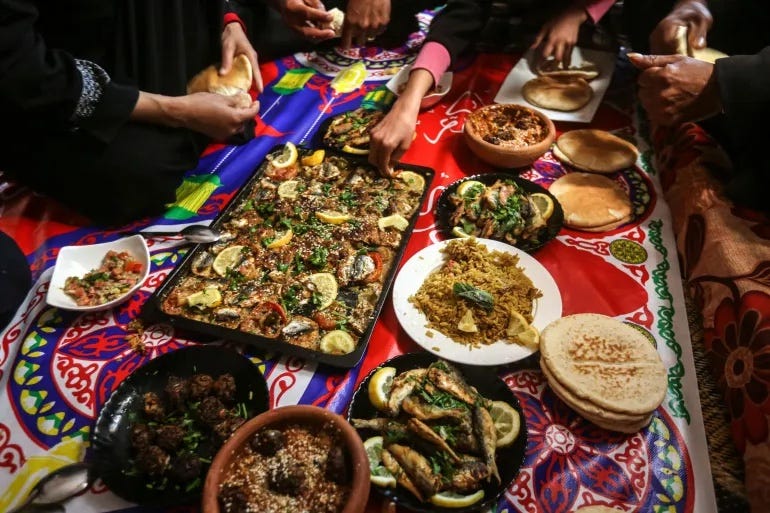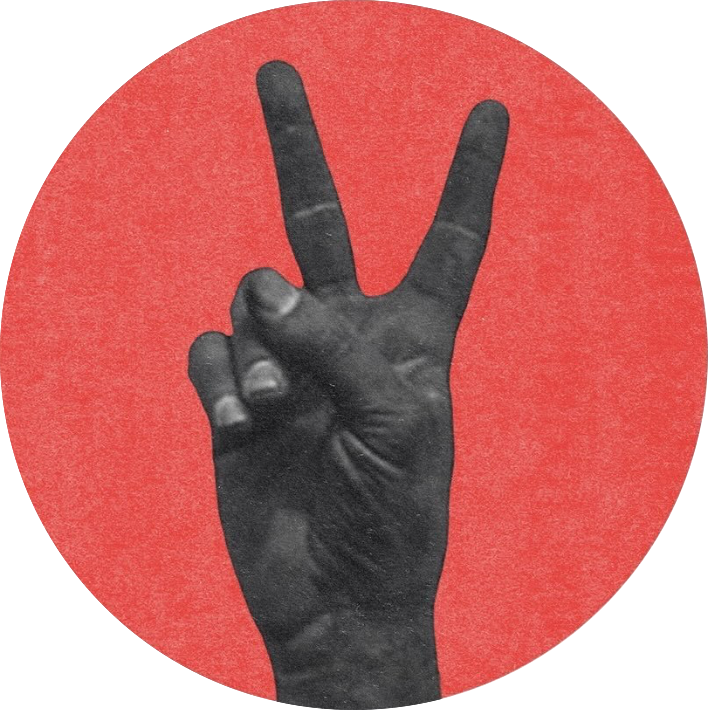Review of 'A Plate of Sardines' (1997)
Our review of A Plate of Sardines (1997), directed by the modernist Syrian filmmaker Omar Amiralay, including his political view of cinema, the town of Quneitra, and details of two Arab-Israeli wars.
4 out of 5 stars, documentary
A Plate of Sardines (طبق السردين) is a 1997 documentary by Syrian filmmaker Omar Amiralay. In only 17 minutes, Amiralay shares his first memory of when he heard of Israel. As the story progresses, with the company of Mohammad Malas, he revisits and documents the ruins of Golan Village of Quneitra which was largely destroyed by the Israeli army following the Six-Day War in 1967 and then, abandoned. There, Amiralay and Malas reflect on their personal stories regarding Israel and its occupation. In this short documentary, Amiralay presents themes of memory and loss of one’s homeland caused by the occupation.
The film begins with Amiralay expressing his disillusionment:
“If I’d known that discussing our struggle with Israel would lead to more despair about the disappearing chances for peace, day after day… If I’d known that beforehand, I certainly would have avoided getting involved in this project.”
By documenting the destruction of Quneitra, where only a single cinema building was left standing a few meters away from the Palestinian-Syrian border, Amiralay wished to instill hope that the long Israeli-Arab conflict would one day achieve peace. Instead, he was met with greater despair, and reflected on how being confronted with such history can feel futile or emotionally exhausting. The documentary, experienced much like a personal essay, also highlights a central theme of the film: the burden of memory, and Amiralay’s inner conflict about whether revisiting trauma either brings clarity or simply worsens the sense of hopelessness.
Through a recorded conversation with his aunt, he recalled his first memory of Israel: as a child, every time he visited his aunt’s house with his mother, a plate of sardines was always there on the table. As a curious 6 year old, he questioned its constant presence and later learned that his uncle worked at a port to make ends meet after being displaced from their hometown in Yaffa, Palestine. For Amiralay, the pungent smell of sardines was not just a mere childhood memory, but has eventually grown to be an enduring reminder of a lost homeland and a history that continues to linger through memory and objects. Amiralay presents this moment on how personal and political histories can become intertwined, and how something as trivial as food can be emotionally tied to trauma of exile.
“I thought my story would rekindle her memory about the suffering of the first flight when they were displaced from Palestine to Lebanon. At the worst, I expected her to share my strong hatred of the smell of sardines.”
— Amiralay expressing his disappointment at his aunt’s indifference
This quote reflected Amiralay’s hope that a shared memory could become an opportunity to emotionally connect with his aunt. To Amiralay, the sardines which reminded him of Israel’s aggression and his family’s forced displacement, instilled a sense of visceral disdain in him where he expected his aunt to share the same sentiment. However, he was disappointed at her lack of intensity, showing how subjective memory and trauma can be. Despite that, Amiralay had an epiphany that justified her indifference: through years of acquired wisdom and at the time of his family’s exile from Yaffa, his aunt accepted that sardines are also a type of food that can be eaten, just like any other fish. When life necessities like food become a struggle to obtain, it shows that one has to make the most of what they have to survive, even if it means having to accept barren reminders of trauma. This realization represents a broader theme in the film where those who share similar history may experience and process it in many different ways.
For a larger fraction of the documentary, it highlights how the Arab world, particularly Syria, were also affected by Israeli forces. As Amiralay and Malas walked through the ruins of the village, they exchanged personal stories and experiences regarding the occupation. Malas, who was born in Quneitra, reflected on his longing for his home and simultaneously brought the central theme of the documentary to life once more: memory.
“The Israelis wanted to leave it as you say, like an open wound, and at the same time, as a lesson for how barbaric they could be.”
As Amiralay and Malas walked through the destroyed village, Amiralay recalled the first time he visited the ruins of Quneitra, and reflected on the statement above quoted by Malas himself. Malas’ words hinted that there was more than meets the eye on the mass destruction of Golan Village and Quneitra itself. He implied that the ruins were not simply collateral damage from war, but rather intentional violence and a strategic offence meant to leave a lasting mark on the land and the surviving civilians. The phrase “open wound” serves as a metaphor that the damage is still ongoing: constantly visible and continuously inflicting pain onto those who experience it. As such, Quneitra becomes more than just a ruined city; it is used by the Israeli forces as a warning to those who resist. Amiralay showed that the destroyed land is not simply remnants from “war” but as a testimony; one that carries a political message meant to instil fear, suppress resistance, and to assert dominance. This idea captures one of the documentary’s intended messages: that the effects of war do not end when the resistance stops; they live on in what’s left behind.
“Omar, I wish you’d known the city, not just through cinema but by actually being there. I wish you could smell the air of Quneitra which always produces a feeling of vitality. Life.”
— Malas recounts his memories of what his hometown once was.
In the next scene, Malas mourned for what was lost: not just a city, but a lived experience which can never be resurrected. He highlighted the division between those who were lucky to have experienced Quneitra in its former glory, a place full of life before its destruction in the hands of the Israeli army and those similar to Amiralay, especially the younger generation, who can only experience Quneitra’s shadows through its ruins and films. “The air of Quneitra” highlights the horrors of war and occupation: it erases not only the physical structures but also its history and the life there itself. Although Amiralay managed to capture the ruined place through the documentary, by bringing forth an awareness how the destruction in the name of protection ruined countless, innocent lives, its core message also indicates how the documentation can never truly grasp the land’s soul.
“In any case, had we known that Quneitra would be destroyed, perhaps one could have hoped to live there, to die there instead of turning it into a memory in his head or pictures in his head.”
Malas also reflected on how losing a home is not restricted to just losing a place to stay; it is also losing a life that could have been lived there. The phrase “perhaps one could have hoped to live there, to die there”, the filmmaker expressed a yearning for a natural relationship with his home: one that involves the natural cycle of life and death, rooted in a place without the interruptions of war and occupation. Quneitra has now become an abstract idea, reduced to mere memory and images. This transformation shows how the brutality of occupation and conflict can strip people of their right to shape their lives accordingly and hence, further emphasizes that cinema alone cannot capture the livelihood of what was lost.
In the ending scene, presumably set at a different area near the Palestinian-Syrian border, depicted an unknown woman who was separated from her family due to the “war” and had to communicate with her sister via walkie-talkie. There, it was shown that the conversation between the two women were in regards to their family members’ wellbeing as well as urging the woman to cross the border to reunite with her family. This moment shows the aftermath of exile and displacement, which separated those who were dear to us while being forced to live in a constant state of uncertainty. What if the woman never reunites with her family? What will they do when food and clean clothing becomes scarce? What if the woman never lives on to see the conflict ending one day? What if tomorrow never came? As the woman quietly watched her loved ones walk away as the sister bade her goodbye, the phrase “Goodbye my sister, goodbye” summarized the emotional weight of the documentary: a farewell not only between relationships, but also between people and their homeland.
Watch ‘A Plate of Sardines’ (1997) here:
Omar Amiralay
“Syria is a dictatorship, but it would be a mistake to understand us as a totalitarian society. For instance, the National Film Organization has made 45 features, but there is not one propaganda film in the modest history of Syrian cinema.”
– Conversation with Lawrence Wright (2006)
Syrian documentary filmmaker Omar Amiralay (عمر أميرالاي) is considered to be one of the pioneers and driving forces of modernist, nonfiction cinema in the Arab world. Born in Damascus in 1944 to a high-ranking officer in the Ottoman military and a Lebanese mother, Amiralay began his artistic career as a student in the Berlin Conservatory, 1965. In 1966, he devoted himself to drama and theatre studies at the Théâtre de la Ville in Paris, before taking classes at the Higher Institute of Cinema Studies at the University of Nanterre in 1968. He later pursued his studies at Paris’ Cinematheque under the tutelage of renowned French director, Jean-Pierre Melville.

When the 1968 student revolt erupted, Amiralay joined the protesters and began to film. He recounted that he was coincidentally holding a 16mm camera and strongly believed that he was the first to film this sort of protest action. He gave the footage to the Nanterre campus’ student office of media communications. Amiralay soon became impassioned with filming more action. In an interview, he explained:
“Documentary cinema in the Arab world is yet a young adventure. When I was of an impressionable age, there was practically nothing in the genre… What inspired me to make films was actually witnessing the 1968 student uprising in Paris. It was almost happenstance that I had signed up at the Institut des Hautes Études Cinématographiques (IDHEC) in Paris. I had been interested in painting, drawing; then I drifted toward theatre. Even when I was a student at IDHEC, I did not take cinema seriously, even though some of our teachers were master filmmakers, like Jean-Pierre Melville. I could not take fiction cinema seriously.”
– Interview with Rasha Salti (2008)
“I was fascinated by the street movements and I plunged myself into them. The very cinematographic act then became more important than shooting itself. One had to be there, with his camera, just as things happened. The camera became the eye; there was a superimposition process. You can only see through the lenses, even with no film in the camera. That’s why I sometimes shot scenes with no film. But I shot them to get the image fixed in my mind, not on film.”
– Omar Amiralay’s recall of May 1968, in ‘A Silent Cinema’ (2001)
Amiralay expressed his young belief in the art of cinema and how documentary-making was revolutionizing film. He noted that at his time and era of filmmaking, it was possible to imagine an alternative counterculture— resistant against mainstream culture and market-oriented production, he was also critical of governments. Instead, Amiralay participated among fellow filmmakers in establishing networks of ciné-clubs, publishing pamphlets and magazines, film collaborations, and international communications with other dissidents. He also noted the significance and intimacy of producing documentaries and non-fiction films: the profound engagement between the filmmaker and the story eventually intertwined after spending countless hours talking to subjects, studying angles, and familiarizing themselves with stories and places.
Amiralay’s first documentary, Film-Essay on the Euphrates Dam (محاولة عن سدّ الفرات) in 1970 was an in-depth documentation on the Baath regime’s construction of the Assad dam on the Euphrates river– a balanced celebration and critique of Syria’s economic development and the effects on rural inhabitants. It won an award at the Leipzig Festival, of which was instrumental to the Arab Alternative Cinema movement in the 1970s.
His second documentary, Everyday Life in a Syrian Village (الحياة اليومية في قرية سورية) in 1974 is an unabashed critique of the Syrian government’s agricultural and land reforms, and ultimately their failure to provide basic amenities to the poor, following the Tabqa Dam on the Euphrates river. This documentary was banned in Syria and remains banned until today. Amiralay would continue down this pathway of filmmaking to his death (cardiac arrest) in 2011— full of political critique. Amiralay knew that his films were banned in Syria and resorted to distributing them to some film pirates. Within two months, “everybody in Damascus had seen it”, he recalled, “it was a digital flood.”
“We must involve ourselves in the struggle for our common salvation. There are no clean hands, no innocents, no spectators. We must all plunge our hands in the mud of the soil. Every onlooker is a coward, or a traitor.”
– Everyday Life in a Syrian Village (1974)
By the mid-1970s, Amiralay took over the Damascus Film Club with fellow modernist filmmaker, Mohammad Malas, from the National Film Organization (NFO). In 1973, the Syrian government appointed someone who could secure the organization’s unchallenged loyalty to the state and inhibited the independence of the institution. In 1974, Amiralay and other filmmakers relinquished their membership to the NFO after a year of disagreements. They fought to elect a new administrative team and to protect its sovereignty, its independence, from political involvement.
The ciné-club kept a low profile for the first few years and hosted screenings in small studios owned by other filmmakers. Before long, the club established a membership system, published newsletters (‘Film’), and organized workshops in scriptwriting and shooting films.
“The interior architecture presented a tremendous challenge to accommodate for installing equipment to project films and an audience to watch comfortably, so we had to innovate. Nazih Shahbandar, a pioneering and veteran Syrian filmmaker, as well as fantastic technician, leapt to our rescue. He created an amazing set-up: the projector was placed in the kitchen and a mirror placed in a connecting hallway carried the reflection to the screen placed in the wide principal room furbished with approximately 80-90 seats. Translation was simultaneous.”
– Interview with Artezine (2008)
This group of Mohammad Malas, Haytham Haqqi, Ma’mun al-Bunni and Omar Amiralay, began to produce two film weeks with Cahiers du Cinéma centred around the theme: ‘Cinema and Politics’. However, the Syrian government banned and censored many films from the program at the last minute. To solve this issue, representatives from Cahiers du Cinéma stood in front of the screen and recounted frame by frame to the audience.

“It was a screening without an image– an absolutely beautiful happening. Rarely have I witnessed moments of magic that rival this one. We were able to humiliate the government’s intimidation and clamp down, it was symbolically resonant at the time. Daney (the Cahiers representative) later recounted his experience in a long article.”
– Interview with Artezine (2008)
The screening events lasted three hours and a discussion followed each film. Impassioned debates provided filmmakers a safe way to discuss their predicament with Syria’s dictatorship. Before long, Amiralay discovered his name on a list of people to be arrested– Assad’s government imprisoned and tortured hundreds of dissidents in 1980. Despite this, the group’s activities in Damascus inspired organizers in other cities to host their own film clubs. A public television channel invited the group to host a program called Nadi al-Sinema (ciné-club). They produced up to 19 episodes and invited guests to discuss the films after each screening, until the presidential palace called their phone to stop the program. By that time, the Nadi had increasingly become a political platform and hosted lectures and talks from critics of the regime and dissidents, from all fields and disciplines: poets, lawyers, and activists who spoke freely, who exposed human rights abuses, and demanded freedom of expression and social justice.
“We hosted the French filmmaker Ariane Mnouchkine and Syrian dissident intellectual and activist Michel Kilo. I think the ‘red line’ transgressed that evening was a discussion of how revolutions end up devouring their own children and betraying their own principles. In spite of its popularity, the program was stopped instantly; phone calls from that far high have that problem.”
– Interview with Artezine (2008)
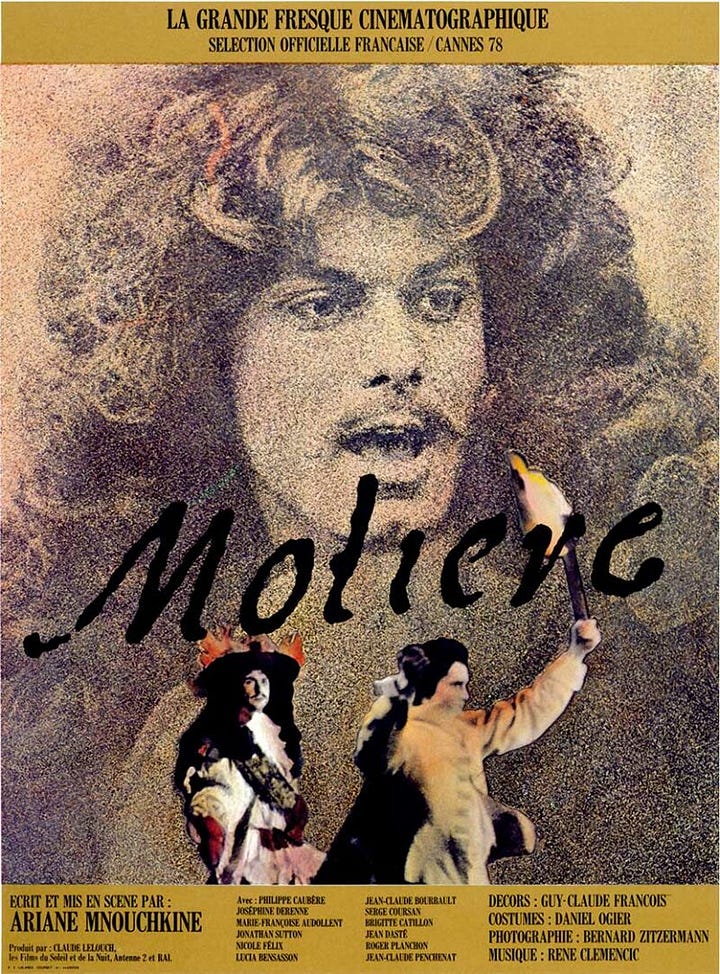
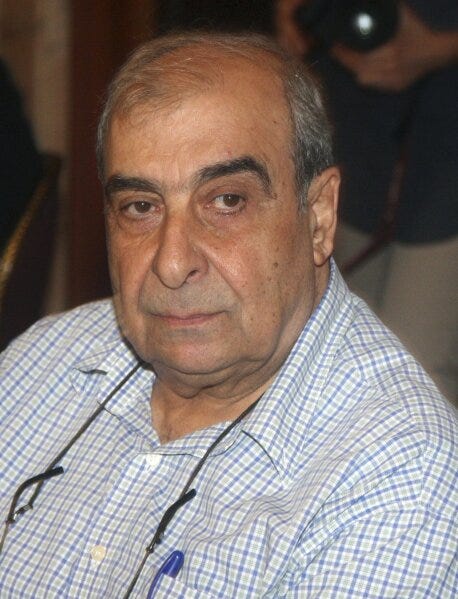
Nadi al-Sinema was briefly resurrected by Mohammad Malas before he had to divert his attention to work on his own feature film in 1983. In 1995, filmmaker Oussama Mohammad resurrected it again, however Nadi’s activities were limited to one activity per year. The Minister of Culture at the time, Najah el-’Attar, prohibited the Nadi from holding activities in foreign cultural centres and were instructed to only screen Syrian films— the film club went on another hiatus due to this political interference.
In 2000, Amiralay was a signatory to the ‘Declaration of the 99’, a manifesto signed by 99 prominent Syrian intellectuals calling for an end to the state of emergency that operated since 1963, the release of all political prisoners and prisoners of conscience, and to permit political parties and independent civil society organizations. He was a prominent participant in the various debates and petitions that characterized the Damascus Spring in 2000. This made a major impact across the Arab world, as the government released hundreds of political prisoners and closed the Mezze prison in November 2000. However, this was short-lived as the Syrian government returned to repressive methods in 2001. Nonetheless, Amiralay and other Syrian intellectuals remained outspoken in 2005 as they called for Syrian withdrawal from Lebanon and to end the attacks on Syrian workers in Lebanon.
“That’s how we started in cinema, as left-wing Marxist filmmakers that saw films as a tool for action, a tool to implement change in consciousness and society. There was a utopian view of the act of filmmaking.”
– Omar Amiralay, in ‘Sorrow, Time, Silence’ (2021)
Quneitra, Golan Heights
Quneitra (ٱلْقُنَيْطِرَة or ٱلْقُنَيطْرَة) is an abandoned town between Syria and Israel, now monitored by the United Nations. It is still the capital of the Quneitra Governorate (province) in southwest Syria— however, the operating capital of the Quneitra Governorate transferred to Madinat al-Salam in 1986— and the town was once an important regional hub and administrative centre. Situated in a valley in the Golan Heights at 1010m (3313ft) above sea level, the region is overlooks the Jordan River and Sea of Galilee on the west, Mount Hermon on the north, Wadi Al-Ruqqād on the east, and the Yarmūk River on the south.
The town was first settled in during the Byzantine era, but was founded after the Byzantine empire fell to the Ottomans as a stop-point on the way to Damascus, and later became home to approximately 20,000 people. Muslim Circassians (of the northwest Caucasus) began to properly settle in the town during the 20th century and made Quneitra their cultural centre. The French-Jewish banker Baron Edmond de Rothschild bought a large plot of Golan Heights for Jewish settlement, and this trend was followed by others in the USA, Canada and Europe. Jewish colonization failed throughout these Jewish-bought lands due to backlash from the Arab population and Ottoman land laws, which forbade non-native settlement. The Golan region became home to Druze, Christians, Alawites, Turkomans, Bedouin tribes, and Muslim Circassians.
As modern Syria began to form after the fall of the Ottoman Empire and World War I in 1922, Golan Heights became part of the Class A Mandate of Syria under French rule, before Syria finally gained independence in 1941. The mandate included Syria because the society in this region was considered to be sufficiently advanced, yet still needed Allied (Britain, France) administrative control as they gained independence. However, conflicts still persisted and arguably, worsened after Western intervention and the creation of Israel. Israel was born amid unresolved disputes over borders, security, and land ownership, leading to multiple Arab-Israeli conflicts from 1948 to now. Notable Arab-Israeli wars include the 1948 Nakba, 1956, 1967, 1973, 1982, 2006, and the 2023 genocide. After the first Arab-Israeli War in 1948-49 (the Nakba), Syria fortified western Golan Heights.
Eventually the town of Quneitra’s culture grew more Arab and by the mid-1960s had become an important road junction, regional market centre, and Syrian military post. Golan Heights was, after all, a land of small villages, agriculture, and livestock herding with fertile soil and abundant water resources. Once a caravan stop on the route between Damascus and the Mediterranean, Quneitra grew and provided large markets each Wednesday and processed local raw materials. Due to this history, Quneitra has been known for its occupation, trade, and culture.

Six-Day War of 1967
Before the Six-Day War, there were heightened tensions between Israel and its Arab neighbours. Palestinian guerilla groups in Syria, Lebanon and Jordan had been attacking Israel in 1966. In November 1966, Israel retaliated and struck Al-Samū: a village located in the Jordanian West Bank. In April 1967, the Israeli Air Force shot down 6 Syrian fighter jets. There were also (inaccurate) rumours that Israel planned on launching a campaign against Syria in May 1967. By the end of May, Egyptian president Nasser mobilized forces in the Sinai Peninsula, removed the UN Emergency Forces, closed shipped routes to Israel, and signed alliance pacts with Jordan and Iraq.
Israel launched preemptive air assaults on the Egyptian and Syrian air forces on 5 June 1967, before the Arab nations had a chance to mobilize. Jordan began to bomb West Jerusalem, and Israel’s counterattacks drove Jordanian forces out of East Jerusalem and most of the West Bank. The UN Security Council called for a ceasefire on 7 June 1967— immediately accepted between Israel and Jordan. Egypt accepted on 8 June 1967. Syria continued to fire shells from large guns in northern Israeli villages.
“Israeli aircraft were diving above our heads to terrorize us and make us leave… they fired their weapons at night to wreak havoc… We could see the tracer bullets like streaks of fire before us… they were firing on anything that moved, cars, and even livestock.”
During the last two days of the Six-Day War of 1967, Israeli engineer troops built access roads up Golan Heights to assault Syrians with armored vehicles and on foot. After the Six-Day War, Quneitra became occupied by Israeli military forces and Golan Heights was integrated into Israeli administration. 5 Arab villages in Golan Heights remained and were offered Israeli citizenship, but most declined and kept their Syrian citizenship. 30 Jewish settlements established in Golan Heights by late 1970s.
In 1976, Israeli war hero and Defense Minister Moshe Dayan opened up to a journalist about the war, but his comments were not made public until 1997:
“I made a mistake in allowing the [Israeli] conquest of the Golan Heights. As Defense Minister I should have stopped it because the Syrians were not threatening us at the time… Of course, [war with Syria] was not necessary.”
— Moshe Dayan, 1976
He noted that he reluctantly gave the order to attack Syria, despite Syria already agreeing to the ceasefire in early June 1967.
Yom Kippur War of 1973
Syrians temporarily regained some parts of Quneitra during the 4th Arab-Israeli War: Yom Kippur of 1973. Egypt and Syria allied together and initiated an attack on 6 October 1973, the Jewish holy day of Yom Kippur (Day of Atonement), until 26 October 1973. This also coincided with the Islamic month of fasting, Ramadan. Syrian forces attacked multiple Israeli brigades in Golan Heights; Major-General Adul Habeisi emphasized the element of tactical surprise in their offensive plan named, Al-Aouda (The Return). The plan consisted of fragmenting Israeli defensive positions and hoped to take the Golan within days.
Egyptian president and Nobel Peace Prize winner Anwar Sadat announced his willingness to reach a peaceful settlement if, in accordance with UN Resolution 242, Israel returned the territories it captured during the Six-Day War. However, Israel rejected these terms and the war intensified until the UN reiterated for an immediate ceasefire agreement. The Egyptian-Israeli agreement was signed on 11 November 1973, and multiple peace agreements between these two countries followed.
The Syrian-Israeli agreement, however, was signed six months later on 31 May 1974. This agreement called for Israeli military forces to withdraw from Quneitra, and Quneitra became part of the demilitarized buffer zone between Syria and Israel. Today, the UN Disengagement Observer Force (UNDOF) still supervises the area but the Syrians eventually decided against resettling in the town.
“Once a community of 70,000 and the relatively prosperous center of a rich agricultural area, Quneitra lies shattered. Most of its buildings are knocked flat, as though by dynamite, or pockmarked by shellfire. Surrounded by rubble and flying dust, Syrian Prime Minister Mahmoud Ayoubi called the destruction ‘barbaric’— without referring to Syria’s part in the fighting— and charged that much of the damage had occurred ‘not in war, but before Israel withdrew’.”
— 8 July 1974, TIME Magazine
The barren ruins of their once beloved Quneitra now serves as a constant reminder of the Israeli occupation.
Foreign Reports Describing Quneitra
From ‘The Times’ daily British newspaper, one month before Israeli withdrawal (6 May 1974):
“[Quneitra is] in ruins and deserted after seven years of war and dereliction. It looks like a wild west city struck by an earthquake and if the Syrians get it back, they will face a major feat of reconstruction. Nearly every building is heavily damaged and scores have collapsed.”
From Edward Mortimer’s comments on Peter Snow’s ‘News at Ten’ (12 May 1974):
“...very few buildings were left standing. Most of these destroyed did not present the jagged outline and random heaps of rubble usually produced by artillery or aerial bombardment. The roofs lay flat on the ground, ‘pancaked’ in a manner which I am told can only be achieved by systematic dynamiting of the support walls inside.”
From ‘The Times’ daily British newspaper (10 July 1974):
“Today the city is unrecognisable. The houses with their roofs lying on the ground look like gravestones. Parts of the rubble are covered with fresh earth furrowed by bulldozer tracks. Everywhere there are fragments of furniture, discarded kitchen utensils, Hebrew newspapers dating from the first week of June; here a ripped-up mattress, there the springs of an old sofa. On the few sections of wall still standing, Hebrew inscriptions proclaim: ‘There will be another round’; ‘You want Quneitra, you’ll have it destroyed’.”
From the Report of the Special Committee to Investigate Israeli Practices Affecting the Human Rights of the Population of the Occupied Territories (UN General Assembly, 1 October 1976):
“4088 of 4180 structures had been destroyed or damaged by deliberate action. Many were destroyed completely leaving no trace. Mosques and churches were destroyed, their rich interior decorations looted, as was the medical equipment of the hospital… The town was systematically destroyed by heavy equipment.”
Sardines in Levantine Cuisine
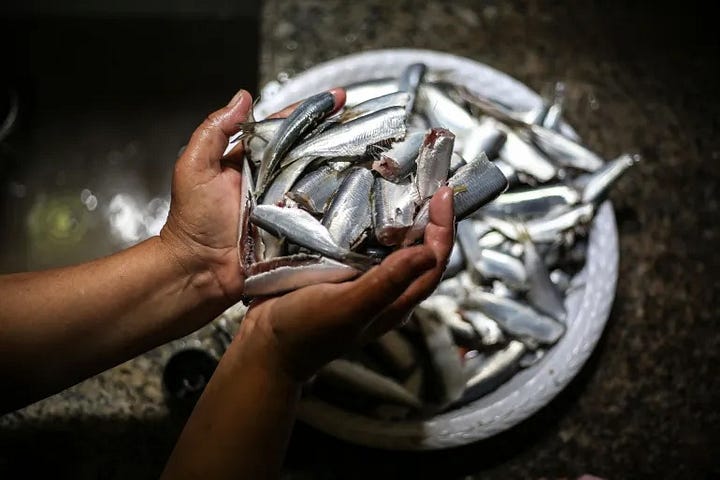
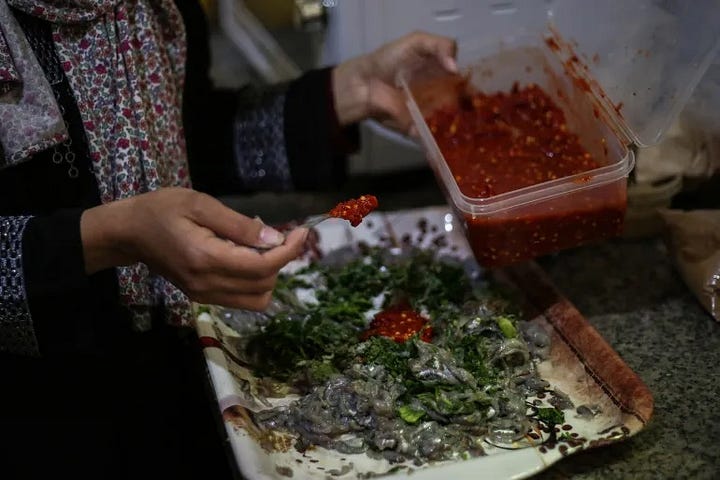
Levantine cuisine is a fusion of culinary traditions that have developed since the Bronze Age, and is a blend of Lebanese, Syrian, Jordanian and Palestinian recipes, traditions, and food culture. Due to the Levant region’s rich history in trade and occupation, their cuisine has also been shaped by interacting with various other civilizations, like: the Phoenicians, Greeks, Romans, Ottomans and Arabs. A broader definition includes Egypt, Türkiye, and Cyprus. Levant cuisine is now known for its vibrant flavours and fresh ingredients, with lots of vegetables, fruit, meat (lamb, chicken, beef), seafood (sea bass, sardines) and dairy.
The Levant is also part of the ‘Fertile Crescent’: a region that stretches from the eastern Mediterranean coast through Mesopotamia to the Persian Gulf. Its rich soil and favourable climate allows for the development of agriculture and growth of ancient civilizations. Gaza has also been a historical port city— its fishing industry was abundant and Gaza City became known for its trade.
“People assume fish will be plentiful for a city on the sea, that the port teems with all kinds of fish but because of the Israeli measures, the sea is besieged, and we can only sail out for a very limited distance.”
– Madelyn Culab, interview with Al Jazeera (2022)
Narratives of Resistance found some different Levantine dishes that you can add sardines to, listed below!
Sardine Kibbeh:
Sardine Kofta:
Sardine Sfiha:
Fried Sardines dipped in Baba Ghanoush:
Fried Sardines with Mutabal Batenjen & Tabouleh:
Fried Baby Sardines with Sesame Crust:
Thanks for reading our post reviewing the documentary, A Plate of Sardines (1997) directed by Omar Amiralay! All opinions stated in our review are held by Narratives of Resistance only— it does not represent the views of anyone else. If you have watched this film, leave a comment below or DM us for a chat! Please check out the hyperlinks if you want to learn more about the late Omar Amiralay’s films, the Damascus Film Club with other Syrian filmmakers, the Six-Day War 1967, Yom Kippur War 1973 and Levantine cuisine.
Special thank you to our guest contributor for watching the film and writing the review part of this article!
Note: Narratives of Resistance is aware that the Egyptian government and Assad’s regime may have also been harsh during the Six-Day War 1967 and Yom Kippur War 1973. However, we have only indulged in the details necessary to understand the film and to apply how the destruction of war affected Quneitra— resulting to Quneitra acting as a symbol today.
If you want to stay updated with our art and cultural engagements, subscribe to our Substack and follow us on Instagram @nor.films — we post event announcements, share charities, and other helpful resources to stay critically educated on resistance art.




